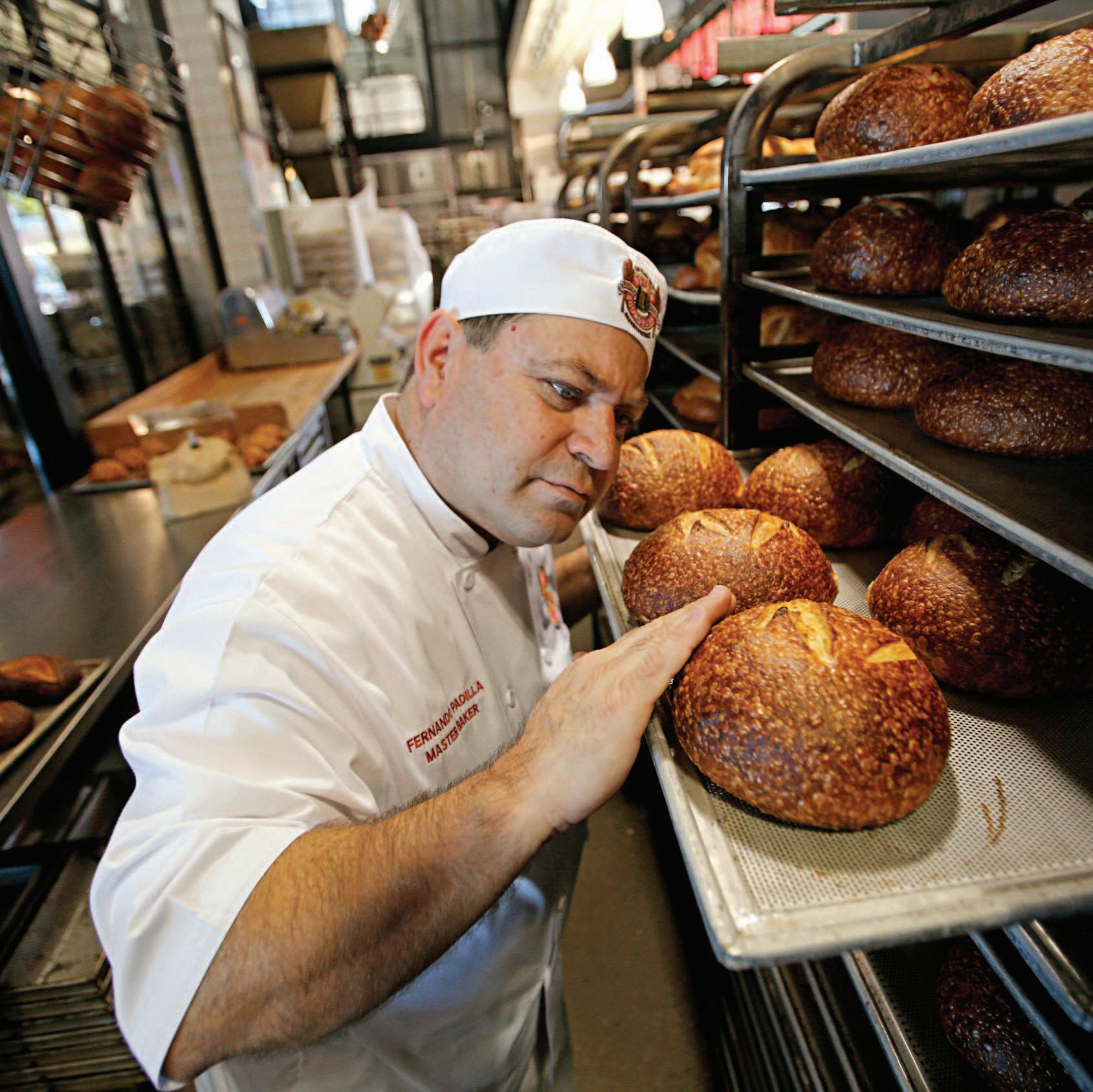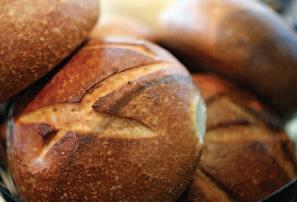
3 minute read
Atasteofhistoryineverybite
burnedto the ground.
Padillaunderstands that,incase of emergency,he’dbe called upon to do the same. Heapprenticed under former Boudin owner “Papa Steve”Giraudo. And late inGiraudo’slife, he handed the reins to Padilla. “Hesat me downandtold me all thethingshe wanted me to take care of,especiallythe mother dough,”says Padilla, who isin his 36th year atthe bakery.“He said to me, ‘Don’tworryaboutthe ups anddowns ofthe business. But if you takecare ofthe breadand the mother dough, they willtake care of you.’And it’strue.”
Padillanowpassesdownsuch lessons tohis underlings. Heteaches classes for Boudinemployees — they callit Sourdough University.

Bakers also learn the science behind why San Francisco sourdough tastes different (andbetter) than anywhereelse onearth. The quick version: SanFrancisco’s foggyweather creates anideal environmentfor thewild yeast and thelactobacilliin sourdough. The ingredients thrive in what Padilla called“a symbiotic colony,”and things work especially well close to San FranciscoBay.The taste simply can’tbereplicatedinother parts of thecountry.
Padillanow oversees theoperation thathas locations all over California.Betweenthethird and fourth weekofeach month, Padilla will ship acontainer of 30 or 40 pounds of mother dough from the flagship. Whenit arrives, theotherbakeries areinstructedto bake theold dough (thusdestroying it) and “start a wholenewbatch so that theyhave a strong injection of the San Francisco starter,”Padillasays.Inall, the Fisherman’sWharflocation pumpsout 20,000pounds ofdough a day.
“Beingable to keepthis alive andhealthy,it’samazing,”Padilla says.“It’shistory.It’spart ofSan Francisco.”
Clockwise fromtop left: A bas-reliefshows Isidore Boudin, the founder of Boudin Bakery; a locked box contains Boudin’smother dough;Victor Gutierrez shapes sourdough rolls; rounds arescored before they are baked. Atright: Master baker Fernando Padilla can talklike a professor, with his references to bacteria, fermentation, andpHlevels. Butwhen he talks about the mother dough, he sounds more oftenlikea doting uncle: “Youneed to keep the mother healthy so shecan keep having babies andbabies andbabies.”

The old militarybunker,once buried in anestof rock, now restsatopacoastal blufflike apartiallyexcavatedfossil.
With itsmetal-and-concrete shell exposed tothe oceanairand covered by graffiti, theWorldWar II observationpostoffHighway1 is SanMateo County’smostevocative reminderofalargelyforgotten era—atimemorethan70 years agowhen theU.S.military and BayArea civilians prepared feverishly foranenemy assault that never came.
Thebunker, the centerpiece ofLittle DevilsSlide Military Reservation, was one of five “fire controlstations” built by the Army atDevilsSlide, betweenPacifica andHalf Moon Bay.Men in thesestations keptalookout for attacking Japaneseships.Their job was to telephonetheenemy’s coordinates to massivegun batteries inthe Marin Headlands and at FortFunston.
Justafew miles down the coast,the Army also built an outpost with a radar tower and anti-aircraft machine gunsalong Pillar Point Bluff(now the Pillar PointAir ForceStation)anda mile-long airstrip(now HalfMoon Bay Airport).
These measureswerepartof asprawlingdefensivesystem the Army began constructing inthe 1930s around themouthofthe GoldenGate.The worktook on new urgency in 1941afterthe JapanesebombedPearlHarbor.
Thebuildup reflectedthe strategic importanceof San Francisco Bay,notonly a vital transportation hub, but also home toMare Island and Hunters Point naval shipyards, among other military installations. TheArmysuspended hundredsofmines inthe ocean outsidethe bayand strung asubmarine net across the inside.
“San Francisco’sharbordefens-
SANMATEOCOUNTY ||| STORYBYAARONKINNEY ||| PHOTOGRAPHSBYPATRICKTEHAN
es were the No.1priorityfor the Corps of Engineers on thePacific Coast,”said StephenHaller,a historian with theGoldenGate NationalRecreation Area. The agencynow owns mostofthe old coastalfortifications.
Amidthisvastmobilization, San MateoCounty’sslightlymore than 110,000residents threw themselvesinto civilian defense initiatives andsalvage drives. The archives of the countyhistory museum preservemuch oftheir efforton thePeninsula.
TheThree CitiesDefense Council,representing San Mateo, Hillsborough and Burlingame, reported in August1942 that its salvagecampaignhad gathered75 tons of scrap metal and 500,000 pounds ofrubber,along with various amounts ofkeys, rags and grease.
All this effortmaynot have matteredmuch in the outcome of the war,but it proved essential for public morale, said Mitch Postel, president of the San Mateo CountyHistoricalAssociation.Andthe Bay Area’sseacoastdefensenetwork, thoughnevertested by the Japanese,served asaneffective deterrent.
Thefire control stations atDevils Slide have faded into semi-obscurity.Public accessisrestricted becauseofthe precariousterrain.
TheLittle Devils Slide bunker acquiredits peculiar appearance afteraMontara man bought the land from the militaryand dug awaymuchofthe bluff, only to abandon his plantodevelop the property.Fewpeople know the odd-looking building is animportant partof theregion’smilitary history.
“It’sakind of a lonely, ghostly structure,”Postel said. “Ithinkpeople passby and say,‘Gee,Iwonder what theheck that is,’andthen nevergiveitanother thought.”
San Mateo County’sLittle Devils Slide Bunker,a triangulation andobservation station from the World War II era, isperched precariously atopDevilsPeak, appearing as if it willslideoff at any moment. Graffiti covers many interior spaces within the structure.

Some celebrities areknown to becompleteasses.None of them, however, wears the label as well as Perry,aminiature donkeywho residesinPalo Alto’s Barron Park neighborhood.
Perry’sclaim to fame? He servedasthe model for thehappy-go-lucky Donkey—voiced by EddieMurphy — whostole scenes and hearts inthe wildly popular computer-animated “Shrek” films.

“Youcan look atthosemovies and reallytellthatit’shim,” says DonAnderson, oneof thetwo dozenorso volunteerswho tend to the animal. “Theyshortened his legsabit andmixedtracesof EddieMurphy’sfaceinwith his, but he’sstillPerry.”
Born in1994 and as photogenic as ever,Perry—shortfor Pericles—liveswithfellow donkey MinerForty-Niner(known as Niner) behindBol Park. Theyare themostrecent inalong line of donkeyswho havehung outhere since theearly 1930s,whentheir turf was part ofapasture owned by thelate Stanford physicistand gentleman farmer CornelisBol.
Thetraditioncontinues,thanks to the generosityofcurrent landowner James Wittand the volunteers who oversee the feedingandwelfare of the donkeys.
EverySunday,Perryand Niner are trottedout to meetvisitors young and old. On occasion, theywill make appearances at local grade schools andkids’ parties.
“It’shard todescribe whyit’s athing,but it is,”Anderson says of the attachment heand others have tothe donkeys.“It’sreallya quaint and distinctiveneighborhoodtradition—somethingthat sets theneighborhoodapart.”
IngeHarding-Barlow, another donkeyhandler,has beenat it long enough to recollecthow Hollywoodcamecallingin thelate 1990s.That’swhenartistsfrom
BYTESACROSSTHEBAY










